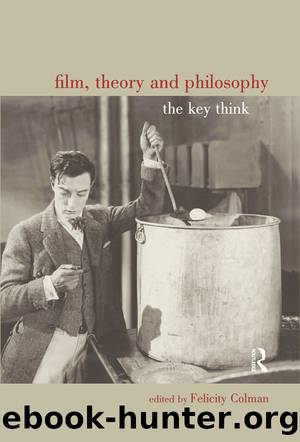Film, Theory and Philosophy by Colman Felicity

Author:Colman, Felicity
Language: eng
Format: epub
ISBN: 9781317492436
Publisher: Taylor & Francis (CAM)
Virilio makes some resolutely militant statements that critically damn the impact of technologies on the human body and its capacity to act, move and think. Because of this critique, his work is often sidelined or ignored by advocates of that system. Virilio refuses to compromise his value-ethics, which observe the detrimental effects of techno-culture on human life and the mutation of “democracy” by government organizations and the commercial media, which contribute in maintaining and managing the state of total war by making militarism a case of “perennial ordinariness” (1990: 35). Throughout his work, Virilio references the philosophical methodologies of the phenomenology of Edmund Husserl and Merleau-Ponty (with whom he studied phenomenology; Redhead 2004: 21). Of particular interest for the study of cinema are the ways in which Virilio develops the phenomenological position in relation to the study of movement. As we have seen with his discussion of the use of the tactic of overexposure by the British military in the Second World War, Virilio regards the phenomenal site as the experience of a (politically/aesthetically/theologically) determined space, which presents itself as a “self-enclosed system, a system of representation the exact configuration of which no one is ready to estimate” (1991b: 116).
Where Merleau-Ponty argues that “the screen has no horizons” (1962: 68) and sight of the horizon is what “guarantees the identity of the object” (ibid.), Virilio contends that our sight is organized by the non-form of the “negative horizon” that we rush towards under the directions of the perceptual management of globalized militarism. Objects are not static, and in the perceptual system of the military gestalt “speed appears as the primal magnitude of the image and thus the source of its depth” (1989: 16). The negative horizon evacuates the history of things and alters the configuration of space. Virilio proposes a new history here for reading the cinematic image. He cites the photographer Nadar from 1863 to describe how the view of a phenomenal definition of objects based on their relational resistance to each other – “one is only supported on what one resists” – has been surpassed by the acceleration of perspective: “space”, he contends, “has become totally dromogenous” (2005: 146–7).
In Negative Horizon: An Essay in Dromoscopy, which acts as the companion volume to War and Cinema (both first published in 1984), Virilio explains his speed-phenomenology, and the dromogenous dimension. Virilio discusses his own phenomenal painting experiments: his attempts to understand the technology of his experience and perceptual expression of things. “The inanimate is merely a derogatory term used by those who read appearances”, he cautions; “those who perceive transparence know well that nothing is immobile, that everything is always moving, that sense circulates among things like blood in the veins, in the forms of the frozen object” (2005: 26). Virilio argues that nothing is immobile, because our cultural destiny is always propelling us to our revisioning: in our redirection of things. Thus you may watch and revision a film over many years, and its forms will have changed their systematic sense as your perceptual situation of sense has been mobilized through time.
Download
This site does not store any files on its server. We only index and link to content provided by other sites. Please contact the content providers to delete copyright contents if any and email us, we'll remove relevant links or contents immediately.
The remains of the day by Kazuo Ishiguro(7551)
Tools of Titans by Timothy Ferriss(6948)
The Black Swan by Nassim Nicholas Taleb(6192)
Inner Engineering: A Yogi's Guide to Joy by Sadhguru(5897)
Giovanni's Room by James Baldwin(5878)
The Way of Zen by Alan W. Watts(5800)
The Six Wives Of Henry VIII (WOMEN IN HISTORY) by Fraser Antonia(4791)
The Power of Now: A Guide to Spiritual Enlightenment by Eckhart Tolle(4755)
Astrophysics for People in a Hurry by Neil DeGrasse Tyson(4620)
Asking the Right Questions: A Guide to Critical Thinking by M. Neil Browne & Stuart M. Keeley(4576)
12 Rules for Life by Jordan B. Peterson(3734)
The Ethical Slut by Janet W. Hardy(3503)
Skin in the Game by Nassim Nicholas Taleb(3461)
Housekeeping by Marilynne Robinson(3401)
The Art of Happiness by The Dalai Lama(3384)
Double Down (Diary of a Wimpy Kid Book 11) by Jeff Kinney(3273)
Skin in the Game: Hidden Asymmetries in Daily Life by Nassim Nicholas Taleb(3264)
Walking by Henry David Thoreau(3234)
12 Rules for Life: An Antidote to Chaos by Jordan B. Peterson(3203)
